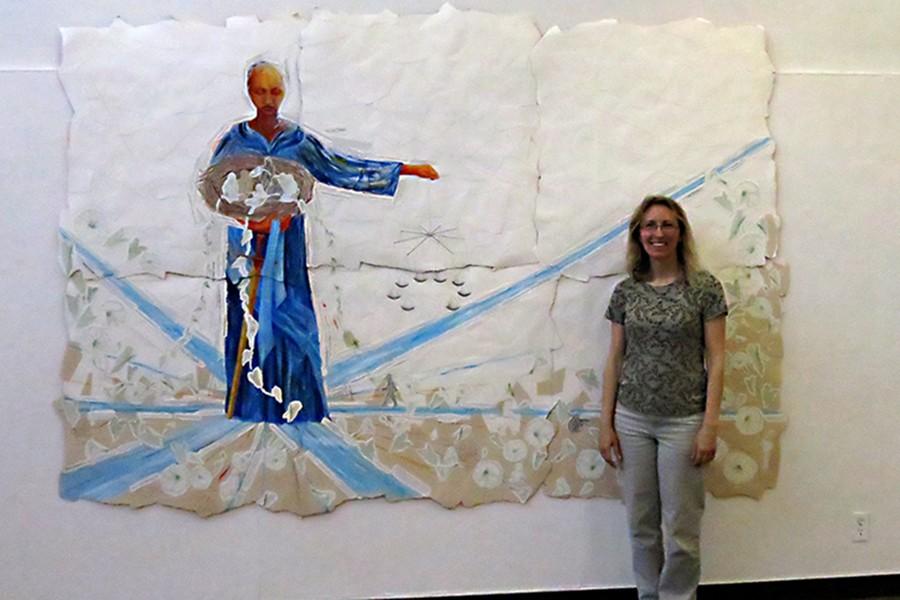Justice system, inequities highlight gallery exhibit
Artist Kim Vanderheiden stands with one of her paintings, “Lady Justice,” in the Eddie Rhodes Gallery on March 17. The exhibit “Working from the Torn Things” will be displayed until April 15.
Apr 11, 2016
The exhibit currently being displayed at the Eddie Rhodes Gallery in A-5 titled “Working from the Torn Things” is a collection of pieces by Oakland artist Kim Vanderheiden.
The theme of the exhibit focuses on justice and the importance of shifting the justice system to become more loving and humane.
The pieces will be displayed until April 15.
Vanderheiden said she has been creating art since she was young but never considered it too much until after college. She studied international relationships and economics in college with the hope of helping in global issues.
She said while focusing on her artwork she is able to tie in her creations to social issues.
“I think it’s relevant,” she said.
Fine and media arts professor Anthony Gordon said, “It gives people a different way to understand the topic.”
All of her pieces in the Eddie Rhodes Gallery, some small and others large enough to cover half of a wall, are made of the same materials.
The material used to create the pieces include torn paper put together to form a collage, pen and ink, letterpress pencil and watercolor.
The idea for using pieces of torn paper put together as a collage came to her when working with a friend to create a portrait of a murder victim.
During the printmaking process used by her friend, there were discarded pieces of paper with phrases on them.
In her pieces for “Working from the Torn Things,” the torn paper has a deeper significance.
It represents the tearing of the social justice system. The method of construction for the pieces is relevant with “so much pain going on.”
Art major Vivien Lee said, “(The exhibit) is a reflection of what is going on in our society. Art should reflect the times you are in.”
A majority of the pieces displayed in the exhibit are collages with only one word per piece, such as truth, crime, law, love and justice.
One of the smaller pieces holds the phrase “white truth black” on it.
“Race underlies the system and we must look at that first,” Vanderheiden said.
Another piece, “Hush!,” includes scraps of paper with Miranda rights written on them. It depicts the silencing enforced in legal settings and the suppression of truth.
Vanderheiden said her interest in the justice system began when she was working for the Alameda County Law Library.
She said she was trying to understand law from “the viewpoint of loving, caring and nurturing,” even though those viewpoints are lacking in the justice system.
After having gathered more information she was able to look more closely into the law’s disconnect from real life situations.
“Where it goes next depends on what we are willing to put up with or not,” Vanderheiden said.
During the reception for the exhibit, Vanderheiden placed an empty box in the center of the room.
She also included scraps of paper and writing materials so that students could leave comments, through the slot at the top of the box, specifically regarding the justice system.
Some of the comments left by students and attendees of the reception included topics regarding white privilege, mass incarceration, police brutality and one comment that read: “Justice! Just you? Just me? Just who?”
The idea behind the box for comments was to create a community art piece.
The comments that have been left so far were put together similarly to Vanderheiden’s other pieces and this creation has been included alongside the other pieces in the current Rhodes Gallery showing.
Students are welcome to continue leaving comments and they will continue to be added to the community art piece until the end of the exhibit on April 15.
She said she hopes that this exhibit will also create a chance for students and the greater campus community to have a conversation regarding the justice system.
“One way to share attitudes about the justice system is taking part in the conversation,” Vanderheiden said.


